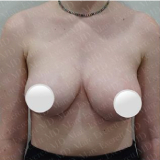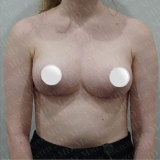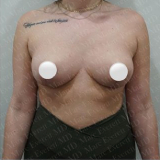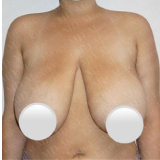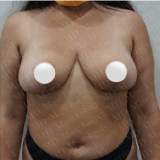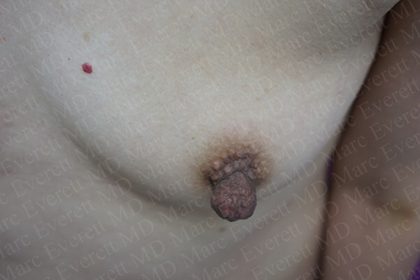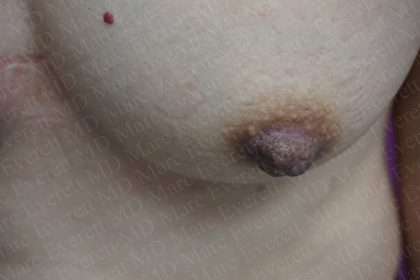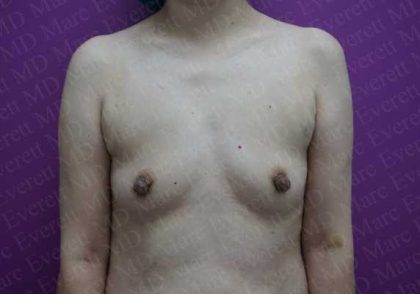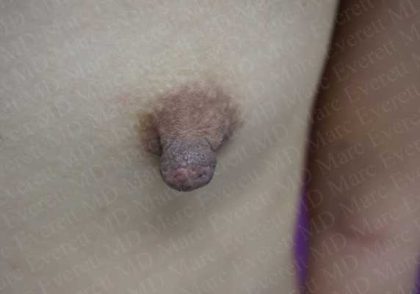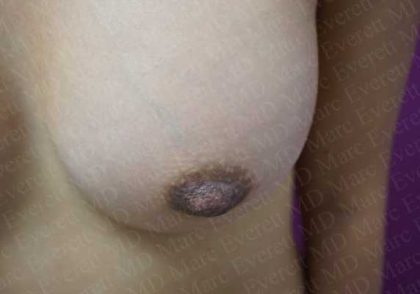Nipple Surgery
Consultations offered at our two convenient locations in Manhattan, NY and Queens, NY
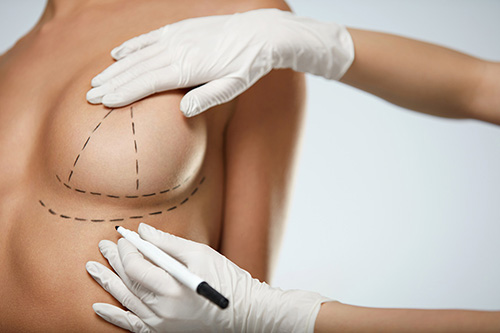
Nipple surgery is a nuanced procedure focused on reducing or reconstructing the nipples and areolas. Dr. Everett has received international renown for his experience in nipple surgery through featured articles by The Daily Mail and the New York Post.
While often referred to interchangeably, the nipple and the areola are actually two different and distinct anatomical structures and the operations to modify them are different as well. The nipple is the conical or dome-shaped protrusion on the breasts that serves as the opening for the milk-producing mammary glands. (1) The areola is the pigmented skin that surrounds the nipple. (1)
Nipple surgery can be performed on one or both of the nipples and areolas for various reasons, including aesthetic improvements, post-mastectomy reconstruction, or correcting specific conditions. One of the most common reasons that men and women seek these procedures is to address the projection of the nipple, but issues with diameter or asymmetry are also common. When treating the areola, the main concerns are generally diameter, symmetry, and its position on the breast.
Nipple surgery aims to create a more balanced and proportionate look for individuals who feel self-conscious about the size, shape, or position of their nipples. Like other cosmetic enhancement procedures, nipple surgery can be tailored to meet your ideal goals. Most of these procedures can be performed awake and conversational with local anesthesia with patients going back to work or home with minimal discomfort. Some patients might opt to have medication prescribed to them to take by mouth to help alleviate the anxiety that some may have during medical procedures. Either way, avoiding general anesthesia for a procedure that should not require it means patients do not have to spend time recovering from anesthesia. Treatment begins with a personal consultation with Dr. Marc Everett, one of New York’s top plastic surgeons and the medical director of The Everett Clinic.
Schedule your consultation today by submitting our online contact form. If you have any further questions, please call either our Manhattan or Queens offices at (212) 774-7715.
Contents
Before and After Photos
About Nipple Surgery
Nipple surgery includes a variety of techniques like nipple reconstruction, nipple reduction, and nipple augmentation. These procedures address different concerns related to the nipple anatomy, which consists of ducts, fatty tissue, connective tissues, and blood vessels. The surrounding area, known as the areola, is the pigmented skin around the nipple and plays an essential role in breast aesthetics. (1) Some patients seek nipple surgery due to the way they developed during puberty or acquired by changes affecting their nipple shape, such as pregnancy or weight loss.
The human breast is composed of glandular tissue, fatty tissue, and connective tissue. For women, the nipple is where the milk ducts open to the outside, allowing for breastfeeding. Both the nipple and areola contribute to the overall appearance of a person’s breasts and can change due to factors such as age, hormonal fluctuations, previous breastfeeding, or significant weight changes.
Statistics indicate that nipple surgery and related cosmetic procedures have gained popularity over the years, with thousands of successful surgeries performed annually by board-certified plastic surgeons. (2)
Benefits
Under the expert care of Dr. Everett, our customized treatment plans help patients see improvements through:
- Increased confidence: Many individuals report heightened self-esteem after nipple surgery, positively impacting their body image and confidence levels as the nipples are considerably less visible through clothing.
- Balanced appearance: Nipple surgery can create more symmetry between the breasts, improving overall visual appeal.
- Restoration post-mastectomy: Patients who undergo nipple reconstruction after mastectomy can regain an important aspect of femininity and self-identity.
- Aesthetic outcomes: With careful attention to detail, nipple surgery can yield natural-looking results.
- Improved comfort: For patients with excessively large nipples, reduction can lead to greater physical comfort and less irritation in clothing.
- Personalization: Nipple surgery can often be customized according to the individual’s preferences, delivering tailored results.
- Minimal scarring: Advanced surgical techniques often allow incisions to be made discreetly, thereby minimizing visible scarring. In fact, it’s incredibly difficult to find the scars within the nipple after healing is complete.
Candidates
Candidates for nipple surgery typically include individuals who express dissatisfaction with their nipple or areola’s size, shape, or position. Candidates may come from diverse backgrounds, including men and women seeking aesthetic enhancements or individuals recovering from breast cancer. Ideal candidates should be in good overall health without any severe underlying medical conditions, not smoke or use any substances that could hinder healing, and have realistic expectations regarding surgery and its outcomes. A personal consultation with Dr. Everett will help determine candidacy and outline personalized options based on your unique anatomy and objectives.
Personal Consultation
Your journey toward nipple surgery begins with a personal consultation. During this appointment, Dr. Everett will discuss your medical history, understand your cosmetic concerns, and perform a thorough examination of the breast anatomy. This will include a measurement of the dimensions of the nipple and areola to create an objective conversation between Dr. Everett and each patient to help them not just qualify, but quantify what bothers them. Before proceeding, we will explain the various surgical techniques available and determine which approach may best suit your needs. It is helpful to prepare any questions you might have regarding risks, recovery times, and expected results during your visit. Dr. Everett ensures every patient feels comfortable and informed throughout the decision-making process.
Schedule your consultation online by submitting our online contact form or calling our Manhattan and Queens offices at (212) 774-7715.
Preparation
Once your nipple surgery is planned, you will receive detailed preoperative instructions. Adhering to these guidelines is crucial for ensuring a smooth surgery and optimal recovery. These instructions may vary depending on the type of procedure you receive and your medical history, but common requirements include:
- Ceasing medications and supplements with blood-thinning properties.
- Quitting nicotine products for several weeks before and during recovery promotes better healing.
- Arranging transportation home after surgery.
Procedure
Nipple surgery is performed almost entirely with local anesthesia, with or without oral sedation. For some more extensive procedures, or those combined with other treatments, Dr. Everett may recommend general anesthesia or IV sedation.
The nipple and areolar procedure is planned meticulously and performed with sophisticated techniques to minimize scarring, reduce discomfort, match a patient’s expected aesthetic results, and preserve nerve sensation in the nipples. (3)
Nipple Reduction
Nipple reductions are the most common nipple surgery procedure that Dr. Everett performs. This procedure seeks to reduce the size of overly prominent or enlarged nipples. By removing excess tissue, we can reshape the nipple to create a more proportionate appearance. Dr. Everett makes small incisions around the base of the nipple, through which excess tissue is removed, allowing for reshaping and resizing. Careful consideration is taken to preserve the surrounding skin and nerves.
Nipple Reconstruction
Nipple reconstruction is available to patients whose nipples have been lost or damaged after trauma, mastectomy, or other causes. (2) Surgical techniques vary based on the extent of the reconstruction required. Options include creating a new nipple from skin available in the area or grafting tissue from elsewhere on the body to form a new nipple, which can take place alongside areola tattooing for enhanced realism.
Recovery
Recovery from these operations is relatively simple and without considerable discomfort. Post-operative pain medication is typically not required. Dr. Everett will give you instructions regarding incision care and return to exercise, which is commonly allowed at 1-2 weeks. Operations that do not require sedation will allow patients to return to work or go home immediately after the procedure.
Results
Once healed, patients can expect nipples that match their ideal image. Because Dr. Everett takes care to preserve nerve sensations and minimize scarring, patients’ new nipples look entirely natural. As swelling is relieved and healing concludes, patients who had experienced discomfort and chafing in clothing are now able to wear bras and tight-fitting shirts much more comfortably. Patients who sought these procedures for noticeable asymmetry will enjoy a nearly identical appearance between one side and the other. These procedures carry high patient satisfaction rates.
Corresponding Procedures
Nipple surgery is a specialized field of cosmetic breast enhancement and rejuvenation procedures. In many cases, the techniques employed in nipple surgery are found in breast lift treatments. Breast lifts, also known as mastopexy, are performed to treat breast ptosis, a condition characterized by deflated, sagging breasts. In many of these cases, the nipples are removed from the breasts and repositioned after the breasts are raised to a higher position.
Nipple surgeries can also be combined with breast augmentation or reduction procedures. Breast augmentation aims to enhance the size and/or shape of the breasts through the use of fat transfers or implants. Breast reductions decrease the size of enlarged breasts to provide women with relief from neck, back, and shoulder pain, as well as relief from embarrassment. For male patients, Dr. Everett offers male breast reductions and gynecomastia treatments. There are many nipple and breast procedure options available to you, so explore your options during a consultation if you are curious about combining these procedures.
Cost of Nipple Surgery in New York City
The overall cost of nipple surgery can vary widely, influenced by the complexity of the procedure and associated anesthesia fees. A comprehensive treatment plan tailored to your individual needs will be provided following your consultation with Dr. Everett, allowing you to fully understand the price of your treatment. Investing in nipple surgery can help you live a life with confidence, which is just as important to your health as it is to your happiness.
Schedule a consultation online today to begin your treatment. If you have any further questions, please call our offices in Manhattan or Queens at (212) 774-7715 to get the information you need.
FAQ
What is nipple reconstruction?
Nipple reconstruction is a surgical option for individuals who have undergone mastectomy. This procedure aims to recreate the nipple’s appearance for aesthetic or psychological benefits.
Is nipple surgery safe?
Nipple surgery is considered safe when performed by a qualified surgeon. Risks do exist, so it is essential to discuss these thoroughly during your consultation with Dr. Everett.
How long does it take to recover after nipple surgery?
Recovery varies among individuals but generally ranges from a few days to several weeks, depending on the procedure performed.
Can I breastfeed after nipple surgery?
Depending on the specifics of the surgery, breastfeeding capabilities may be affected. Be sure to discuss any breastfeeding considerations with Dr. Everett before surgery.
Does nipple surgery leave visible scars?
While scarring is an inevitable consequence of any surgical procedure, Dr. Everett employs advanced techniques designed to minimize and hide scarring effectively.
References
- Braza ME, Sisti A. Nipple-Areolar Complex Reconstruction. Nih.gov. Published July 19, 2023. Accessed March 7, 2025. https://www.ncbi.nlm.nih.gov/books/NBK558981/
- Vendemia N, Mesbahi AN, McCarthy CM, Disa JJ. Nipple Areola Reconstruction. The Cancer Journal. 2008;14(4):253-257. doi:https://doi.org/10.1097/ppo.0b013e31817fbe72
- Schlenz I, Rigel S, Schemper M, Rafic Kuzbari. Alteration of Nipple and Areola Sensitivity by Reduction Mammaplasty: A Prospective Comparison of Five Techniques. Plastic and Reconstructive Surgery. 2005;115(3):743-751. doi:https://doi.org/10.1097/01.prs.0000152435.03538.43


